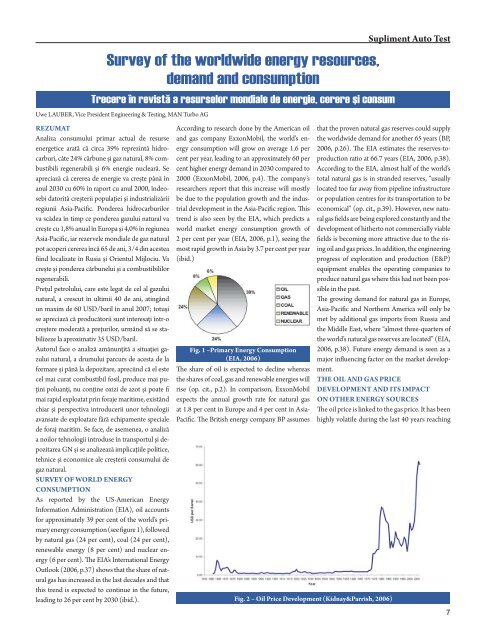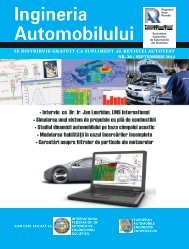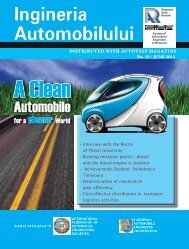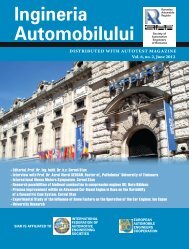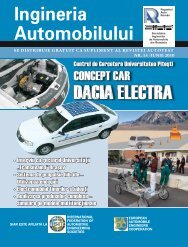automobilul modern - ingineria-automobilului.ro
automobilul modern - ingineria-automobilului.ro
automobilul modern - ingineria-automobilului.ro
You also want an ePaper? Increase the reach of your titles
YUMPU automatically turns print PDFs into web optimized ePapers that Google loves.
REZUMAT<br />
Analiza consumului primar actual de resurse<br />
energetice arată că circa 39% reprezintă hid<strong>ro</strong>carburi,<br />
câte 24% cărbune și gaz natural, 8% combustibili<br />
regenerabili și 6% energie nucleară. Se<br />
apreciază că cererea de energie va crește până în<br />
anul 2030 cu 60% în raport cu anul 2000, îndeosebi<br />
datorită creșterii populaţiei și industrializării<br />
regiunii Asia-Pacifi c. Ponderea hid<strong>ro</strong>carburilor<br />
va scădea în timp ce ponderea gazului natural va<br />
crește cu 1,8% anual în Eu<strong>ro</strong>pa și 4,0% în regiunea<br />
Asia-Pacifi c, iar rezervele mondiale de gaz natural<br />
pot acoperi cererea încă 65 de ani, 3/4 din acestea<br />
fi ind localizate în Rusia și Orientul Mijlociu. Va<br />
crește și ponderea cărbunelui și a combustibililor<br />
regenerabili.<br />
Preţul pet<strong>ro</strong>lului, care este legat de cel al gazului<br />
natural, a crescut în ultimii 40 de ani, atingând<br />
un maxim de 60 USD/baril în anul 2007; totuși<br />
se apreciază că p<strong>ro</strong>ducătorii sunt interesaţi într-o<br />
creștere moderată a preţurilor, urmând să se stabilizeze<br />
la ap<strong>ro</strong>ximativ 35 USD/baril.<br />
Autorul face o analiză amănunţită a situaţiei gazului<br />
natural, a drumului parcurs de acesta de la<br />
formare și până la depozitare, apreciind că el este<br />
cel mai curat combustibil fosil, p<strong>ro</strong>duce mai puţini<br />
poluanţi, nu conţine oxizi de azot și poate fi<br />
mai rapid exploatat prin foraje maritime, existând<br />
chiar și perspectiva int<strong>ro</strong>ducerii unor tehnologii<br />
avansate de exploatare fără echipamente speciale<br />
de foraj maritim. Se face, de asemenea, o analiză<br />
a noilor tehnologii int<strong>ro</strong>duse în transportul și depozitarea<br />
GN și se analizează implicaţiile politice,<br />
tehnice și economice ale creșterii consumului de<br />
gaz natural.<br />
SURVEY OF WORLD ENERGY<br />
CONSUMPTION<br />
As reported by the US-American Energy<br />
Information Administration (EIA), oil accounts<br />
for app<strong>ro</strong>ximately 39 per cent of the world’s primary<br />
energy consumption (see fi gure 1), followed<br />
by natural gas (24 per cent), coal (24 per cent),<br />
renewable energy (8 per cent) and nuclear energy<br />
(6 per cent). Th e EIA’s International Energy<br />
Outlook (2006, p.37) shows that the share of natural<br />
gas has increased in the last de cades and that<br />
this trend is expected to continue in the future,<br />
leading to 26 per cent by 2030 (ibid.).<br />
Survey of the worldwide energy resources,<br />
demand and consumption<br />
Trecere în revistă a resurselor mondiale de energie, cerere şi consum<br />
Uwe LAUBER, Vice President Engineering & Testing, MAN Turbo AG<br />
According to research done by the American oil<br />
and gas company ExxonMobil, the world’s energy<br />
consumption will g<strong>ro</strong>w on average 1.6 per<br />
cent per year, leading to an app<strong>ro</strong>ximately 60 per<br />
cent higher energy demand in 2030 compared to<br />
2000 (ExxonMobil, 2006, p.4). Th e company’s<br />
researchers report that this increase will mostly<br />
be due to the population g<strong>ro</strong>wth and the industrial<br />
development in the Asia-Pacifi c region. Th is<br />
trend is also seen by the EIA, which predicts a<br />
world market energy consumption g<strong>ro</strong>wth of<br />
2 per cent per year (EIA, 2006, p.1), seeing the<br />
most rapid g<strong>ro</strong>wth in Asia by 3.7 per cent per year<br />
(ibid.)<br />
Fig. 1 –Primary Energy Consumption<br />
(EIA, 2006)<br />
Th e share of oil is expected to decline whereas<br />
the shares of coal, gas and renewable energies will<br />
rise (op. cit., p.2). In comparison, ExxonMobil<br />
expects the annual g<strong>ro</strong>wth rate for natural gas<br />
at 1.8 per cent in Eu<strong>ro</strong>pe and 4 per cent in Asia-<br />
Pacifi c. Th e British energy company BP assumes<br />
Supliment Auto Test<br />
that the p<strong>ro</strong>ven natural gas reserves could supply<br />
the worldwide demand for another 65 years (BP,<br />
2006, p.26). Th e EIA estimates the reserves-top<strong>ro</strong>duction<br />
ratio at 66.7 years (EIA, 2006, p.38).<br />
According to the EIA, almost half of the world’s<br />
total natural gas is in stranded reserves, “usually<br />
located too far away f<strong>ro</strong>m pipeline infrastructure<br />
or population centres for its transportation to be<br />
economical” (op. cit., p.39). However, new natural<br />
gas fi elds are being explored constantly and the<br />
development of hitherto not commercially viable<br />
fi elds is becoming more att ractive due to the rising<br />
oil and gas prices. In addition, the engineering<br />
p<strong>ro</strong>gress of exploration and p<strong>ro</strong>duction (E&P)<br />
equipment enables the operating companies to<br />
p<strong>ro</strong>duce natural gas where this had not been possible<br />
in the past.<br />
Th e g<strong>ro</strong>wing demand for natural gas in Eu<strong>ro</strong>pe,<br />
Asia-Pacifi c and Northern America will only be<br />
met by additional gas imports f<strong>ro</strong>m Russia and<br />
the Middle East, where “almost three-quarters of<br />
the world’s natural gas reserves are located” (EIA,<br />
2006, p.38). Future energy demand is seen as a<br />
major infl uencing factor on the market development.<br />
THE OIL AND GAS PRICE<br />
DEVELOPMENT AND ITS IMPACT<br />
ON OTHER ENERGY SOURCES<br />
Th e oil price is linked to the gas price. It has been<br />
highly volatile during the last 40 years reaching<br />
Fig. 2 – Oil Price Development (Kidnay&Parrish, 2006)<br />
7


